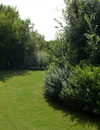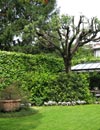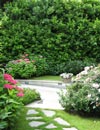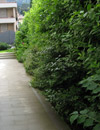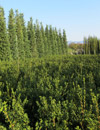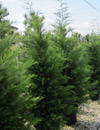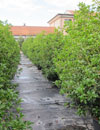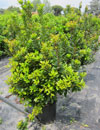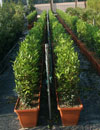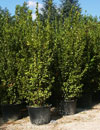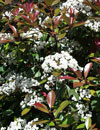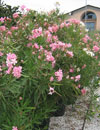HHedges and Screens
The aim of a hedge is to contain a space, demarcate a boundary, screen undesirable views, form a side scene protecting from prying eyes or more simply decorate a garden at its limit
In this space you will find useful information for your landscaping work. If you wish either an ornamental hedge, possibly made up of different kinds of plants for a greater aesthetic effect, or a simple shielding barrier, please contact us; we shall recommend the right solution for you.
You can choose between small plants, to limit the implementation costs, or larger plants for an immediate effect: plants with 40/60 cm to 2,50 m heights are available. They are very suitable for the creation of formal or natural hedges.
Special plants in container and Plant-Plast
These are very large plants useful to create large screens or barriers. They are available in washtub or Plant-Plast with heights varying from three to ten or more meters.
Each garden needs a hedge suitable for the building architecture or the kind of environemnt in which it will be carried out. Below you will find some examples to help you choose the best.
Hedges for small gardens
Autumn Camellia (Camellia sasanqua)
Beautiful shrub with a compact bearing, small dark-green shiny leaves. Abundant and fragrant flowering in October/December. It prefers loose, not too chalky soil and can become two/three meters high with an average height of 1,5/2 meters in the gardens.
Sea boxwood (Myrsine africana)
Compact shrub with small bright light green leaves resembling vaguely box-wood (Buxus). It is very suitable for different kinds of soil and resistant to saltiness, can be two meters high with an average height of 1 – 1,5 meters.
Photinia – Red laurel (Photinia fraseri "Red Robin")
Vigorous, rustic plant, leaves of new vegetation are bright red changing to dark green. Abundant white flowers. It has been replacing laurel (Prunus laurocerasus) for some years in the hedges. It quickly reaches 2,5 m in height.
American laurel (Prunus caroliniana)
Wonderful plant with a compact bearing and deep green leaves, rosy pink in the new vegetation. It grows quickly, is suitable for different kinds of soil, has the typical panicle flowers of laurels and can reach a maximum height of about four meters. Its average height is m 2,50.
Portugal laurel (Prunus lusitanica)
Natural conical bearing. Its glossy deep green leaves resemble the peach's. It is suitable for different kinds of soil, has the typical panicle flowers of laurels and can reach a maximum height of about four meters. Its average height is m 2,50.
Viburnum tinus grandiflorum
Rustic shrub with an abundant winter/spring flowering, glossy dark green leaves, bright light green in the new vegetation. It quickly reaches a height of m 1,5/2, maximum 3.
Boxwood (Buxus sempervirens)
Spread throughout Italy for formal hedges and Italian-style gardens, it is ru-stic with a compact bearing. It is very used to divide spaces within gardens and has an average height of about m 1/1,5.
Hedges for medium to large gardens
Laurel (Laurus nobilis)
Very spread in the central and southern Italy and in the coastal areas, it is a rustic, quickly growing plant. It can reach large sizes. Average management height m 3 x m 1 width. In formal hedges it needs to be pruned at least twi-ce.
Holly oak (Quercus ilex)
Rustic, resistant to salty winds, it grows slowly but can reach a height of m 6/7. Spread in the central and southern italy, it is used to create large for-mal hedges in historical gardens and natural screens sometimes associated with plants such as Laurus nobilis, Arbutus unedo and Viburnum tinus.
American cypress (Cupressocyparis leylandii)
Quickly growing, rustic conifer, it can reach a height of 9 m and is very sui-table to create very quickly large protection screens and windbreaks.
Osmanthus spp.
Shrub with a globular bearing and deep dark green leaves. Abundant, not very showy but fragrant flowering in October. It can be used to create ho-mogeneous hedges or in kinds differing from one other for their shape and the leaf colour.
Hornbeam (Carpinus betulus)
Plant with large leaves keeping in winter dried foliage. It is very used in the northern European countries and spread even in Emilia Romagna, Lombardia and Piemonte. Its growth is rather quick and allows the plant to easily reach a height of m 5.
Magnolia (Magnolia grandiflora spp.)
It is the typical Magnolia of parks. If it is properly transplanted, it can be used to carry out large shielding barriers reaching a height of over ten me-ters. M. grandiflora (light green leaves) and M. g. gallisoniensis "Bionda" (very large bright light green leaves with emerald reflections) are intere-sting for their growth speed and brilliance.
Yew (Taxus baccata)
Mainly spread in the north-central Italy, it is a conifer with a compact bea-ring. It prefers loose, deep and well drained soil, grows slowly, has an ave-rage height of m 1,50 but can reach up to 3 meters.
Hedges for sea areas
Sea boxwood (Myrsine africana)
Compact shrub with small bright light green leaves vaguely resembling box-wood (Buxus). It is suitable for different kinds of soil and resistant to salti-ness, reaches a height of two meters with an average height of m 1/1,50.
Westringia (Westringia fruticosa)
Small delicate-looking shrub. The appearance and colour of its foliage is vaguely reminiscent of a lavender or a santolina. This shrub has indeed a vi-gorous growth and can quickly reach up to two meters in height. It is a very rustic plant able to live very near the sea producing small white flowers throughout the summer.
Griselina (Griselina littoralis)
Vigorous shrub with an enlarged bearing and glossy light green leaves. Its flowers are small and light yellow. Strong resistance to saltiness, it can grow very near the sea.

